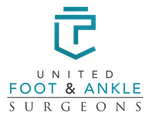MINIMALLY INVASIVE FOOT SURGERY
OUR SERVICES
One of our main podiatry services here at United Foot & Ankle Surgeons (UFAS) is minimally invasive foot surgery. These procedures can be performed through extremely small incisions to correct many painful foot diseases and conditions, including bunions, hammertoes, stiff big toe, painful calluses, diabetic foot ulcerations, heel pain, warts, and much more. Additionally, minimally invasive foot surgery allow us to perform these as outpatient procedures, meaning you can go home the same day after the surgery. But what exactly is minimally invasive foot surgery and what are its benefits?
WHAT IS MINIMALLY INVASIVE FOOT SURGERY?
Minimally invasive foot surgery refers to a type of surgery done with a very small incision that requires little or no stitching. Through these extremely small incisions, surgeons insert specially designed instruments to perform the operation. Interventions are carried out through these small incisions and they have minimal exposure to the surgical field, causing minimal or no injury to the adjacent tissue. Because of this, minimally invasive foot surgery allows us to be able to control and predict a patient’s recovery and outcome more manageable.
Minimally invasive surgery is first pioneered by Dr. Morton Polokoff in 1945, he developed these techniques as a system of sub dermal surgery using very small instruments. In the decades since then, further surgical advancements have led to the state of art procedures that we perform today, making minimally invasive surgery much safer and more comfortable for patients. However, these minimally invasive foot surgeries should be performed only by trained surgeons. They acquire these specialized surgical skills only after extensive training, continuing education, seminars, and fellowship within minimally invasive foot surgery community.
IS MIS(MINIMALLY INVASIVE SURGERY) AN EFFECTIVE TECHNIQUE?
We strongly believe MIS is a very effective surgical technique. It is best summarized by one of my colleagues' website of The Coeur d'Alene Foot and Ankle Clinic and Surgery Center. It says,
"Today, ambulatory foot surgery is a developed art. Over 2,000 international physicians and surgeons specializing in this technique are members of The Academy of Ambulatory Foot and Ankle Surgery, and with each year the number increases. The triangular academy seal depicts its dedication to ambulation, rehabilitation, and education....
It is now over forty years since the original pioneers began the development of this art. They sought the means of ending discomfort and suffering for a wider cross section of the population. They reasoned that if the necessity for hospitalization and prolonged disability was eliminated, more people could afford to avail themselves of these advanced services.
As their development progressed they found that it was rarely necessary to incapacitate their patients. Painful bunions, recurring corns, heel spurs, contracted toes and hammertoes were corrected by this new technique and the patients remained ambulatory. Through the years, other interested physicians and surgeons made worthwhile contributions until we have reached today’s state of the art. Cost effective, minimal invasive foot surgery is a reality."
Patient shares her experience of minimally invasive bunion surgery during 3 weeks of her follow up.
WHAT ARE THE BENEFITS OF MINIMALLY INVASIVE SURGERY?
Minimally invasive foot surgeries provide many benefits, including:
Patient shares her experience of minimally invasive hammertoe procedure. She had painful corns and long toes that are causing lots of problems with shoes that she wanted to wear. This video was taken, 3 months after the procedure.
Listen in as Niki shares her experience about EOTTS-HyProCure ® Procedure and Minimally Invasive Hammertoe procedure in the office-based surgical suite. This video was taken 5 days after the procedure.
We perform minimally invasive surgeries whenever possible. As these procedures may be beneficial to you, your surgeon will discuss all options prior to your surgery.
Please call us at 773-989-2500 or click below to schedule an appointment online!
